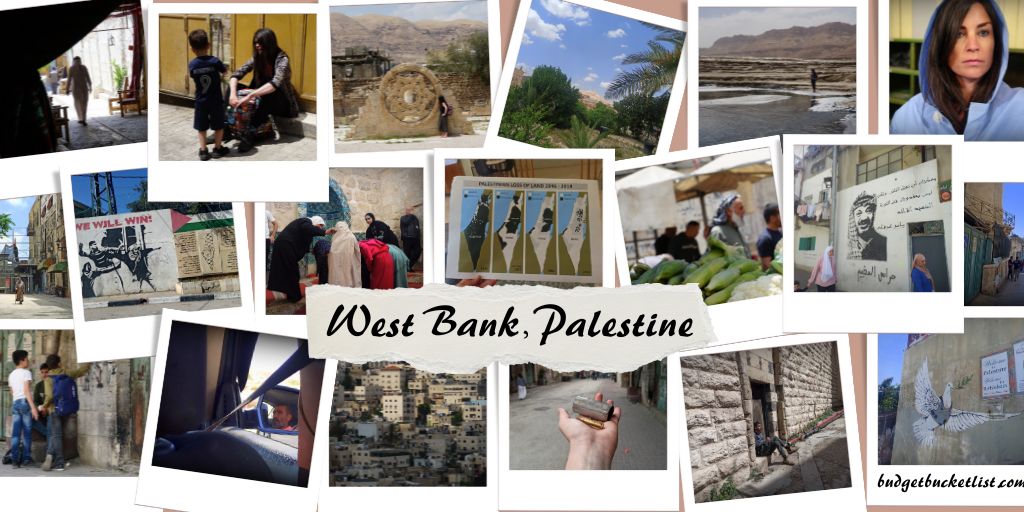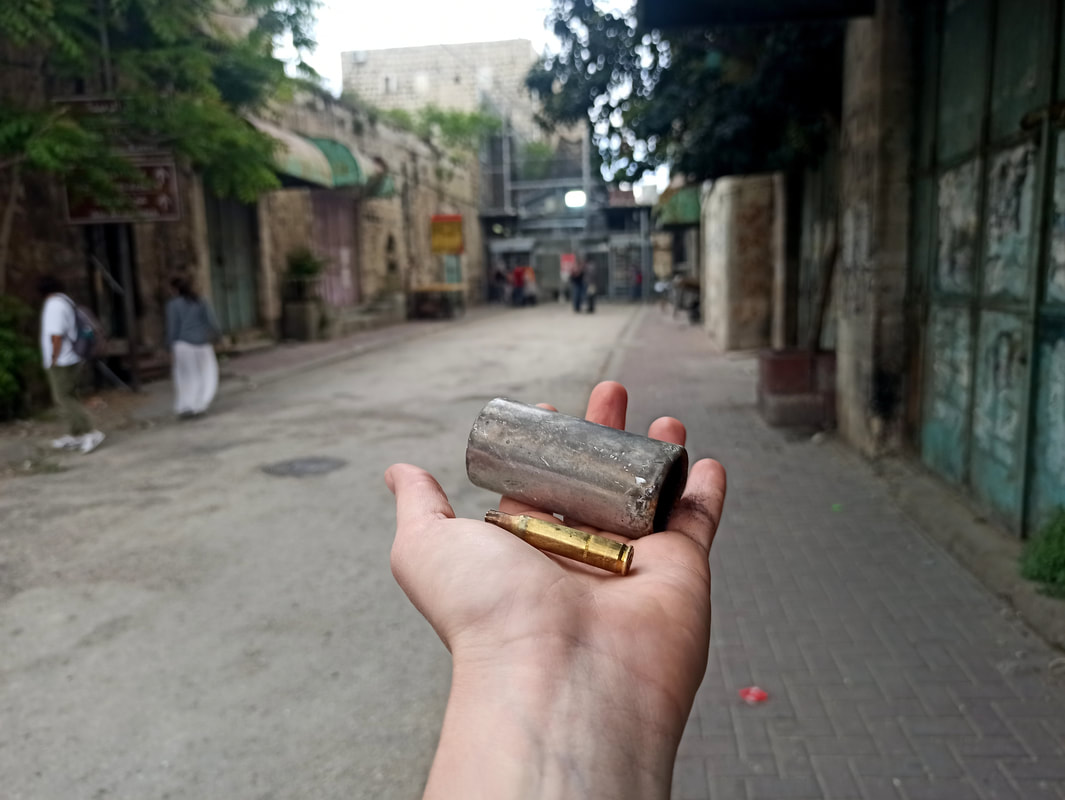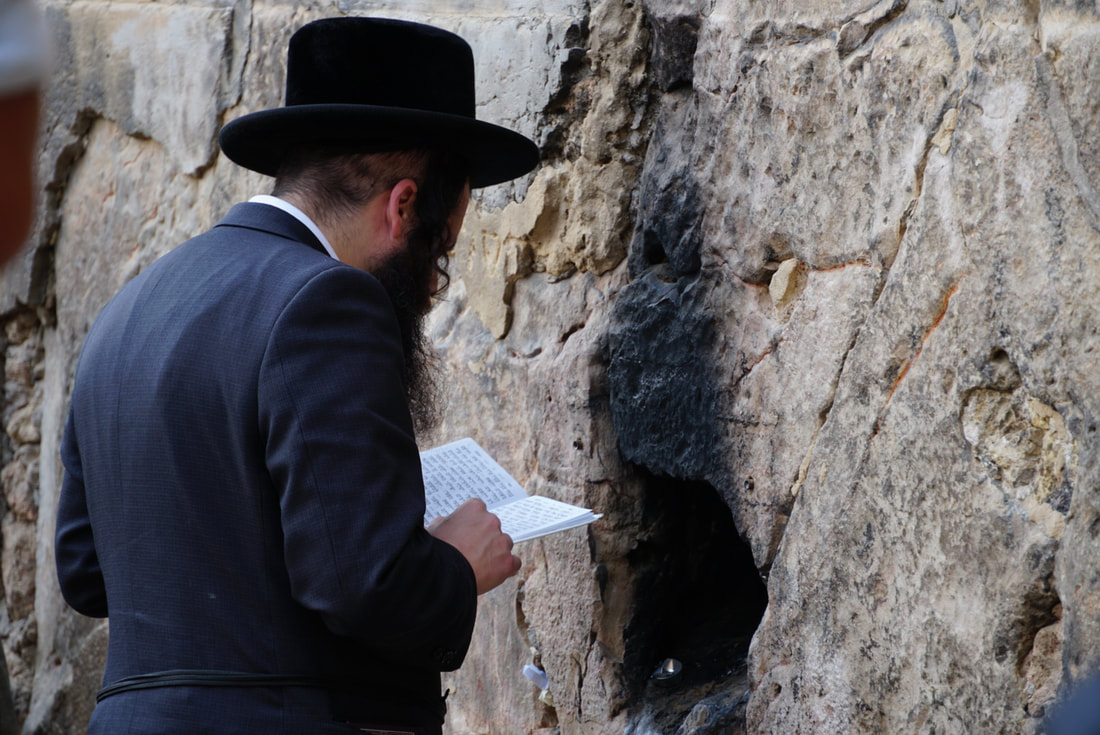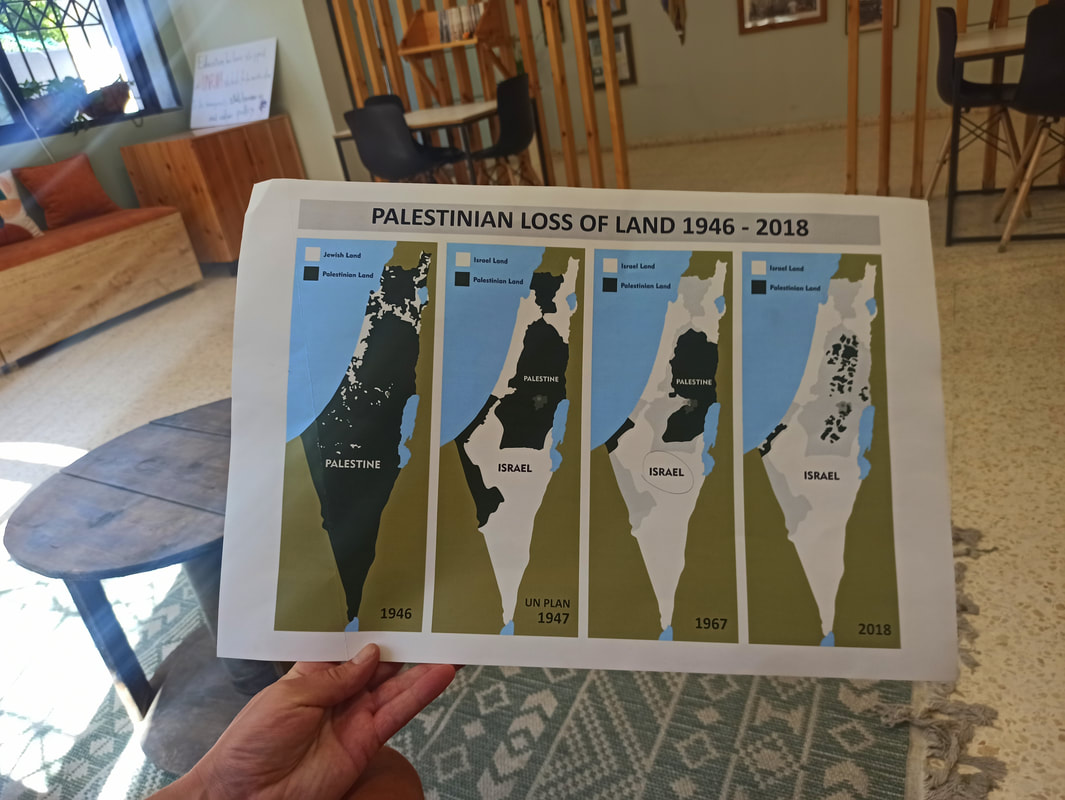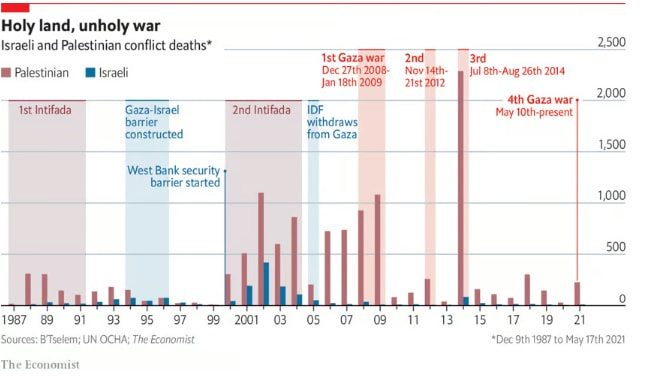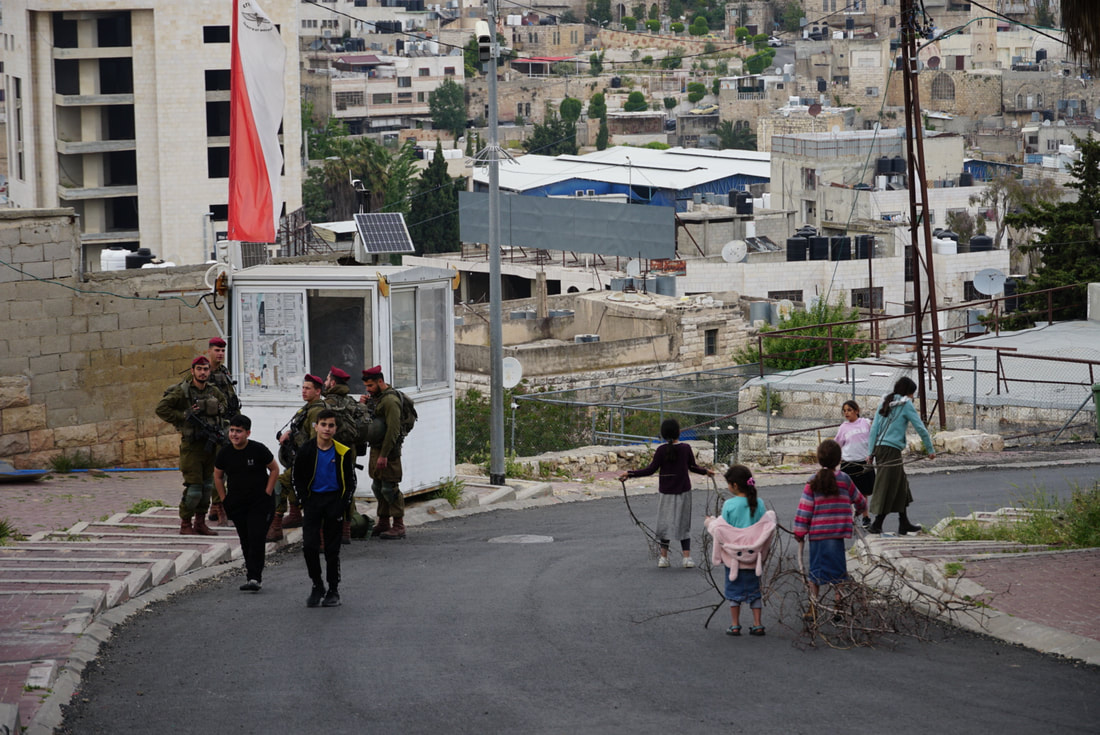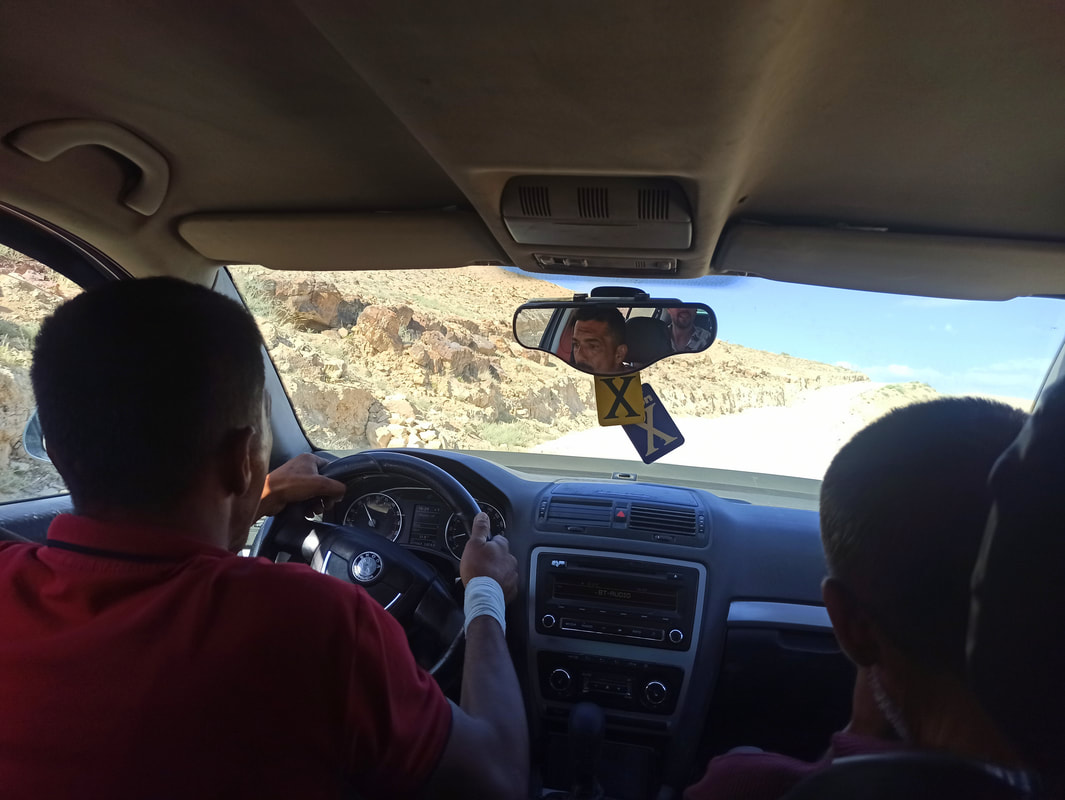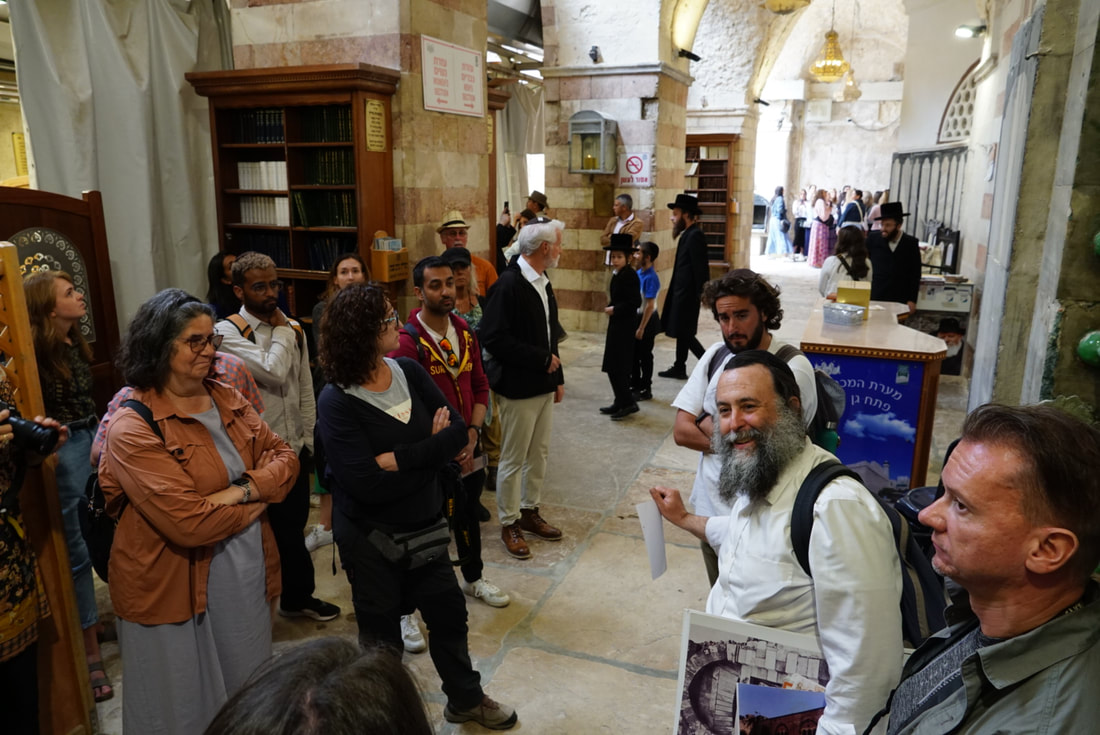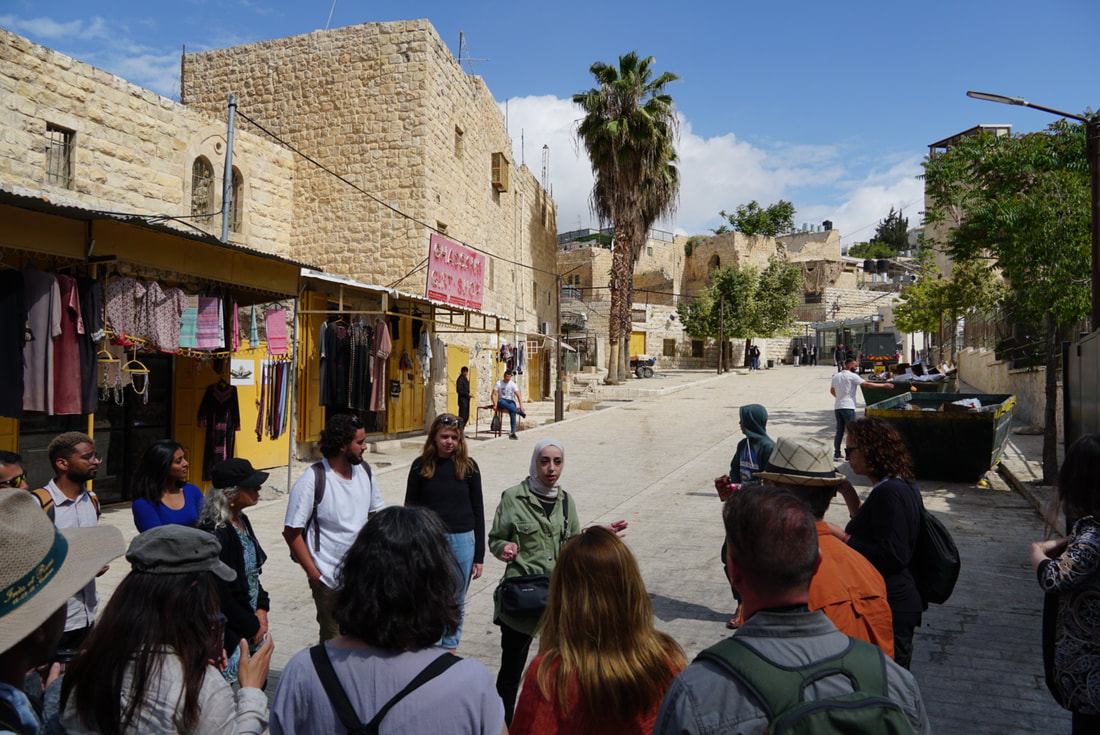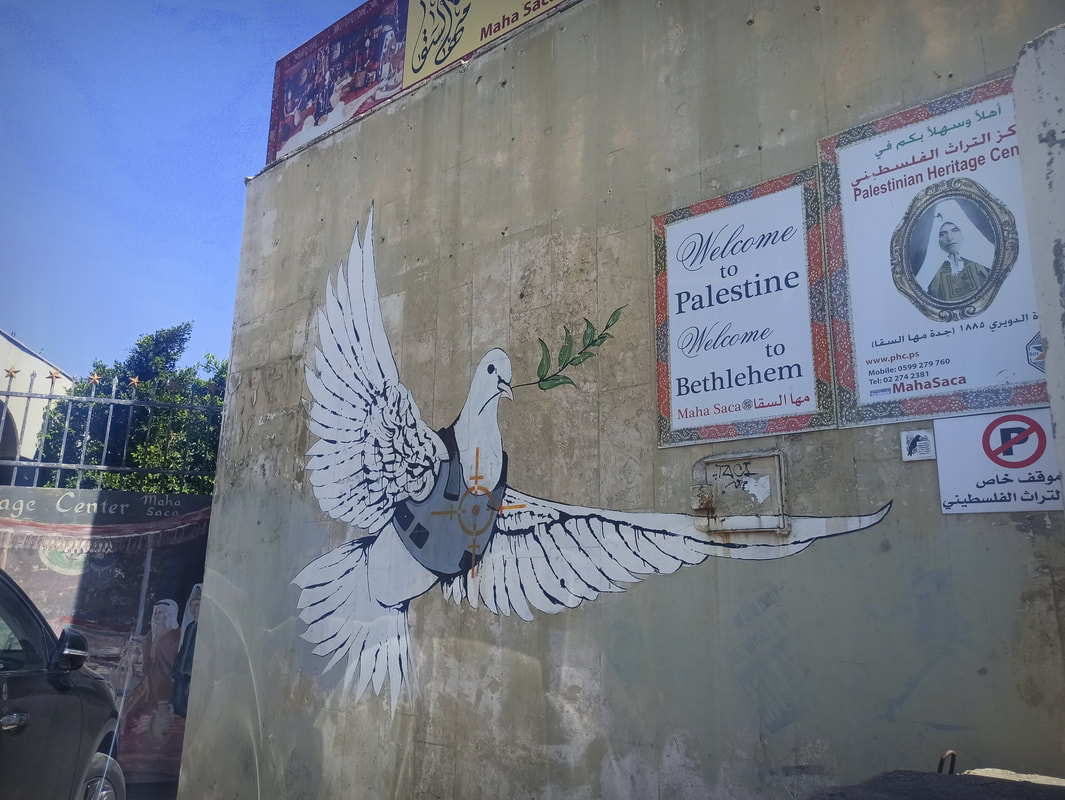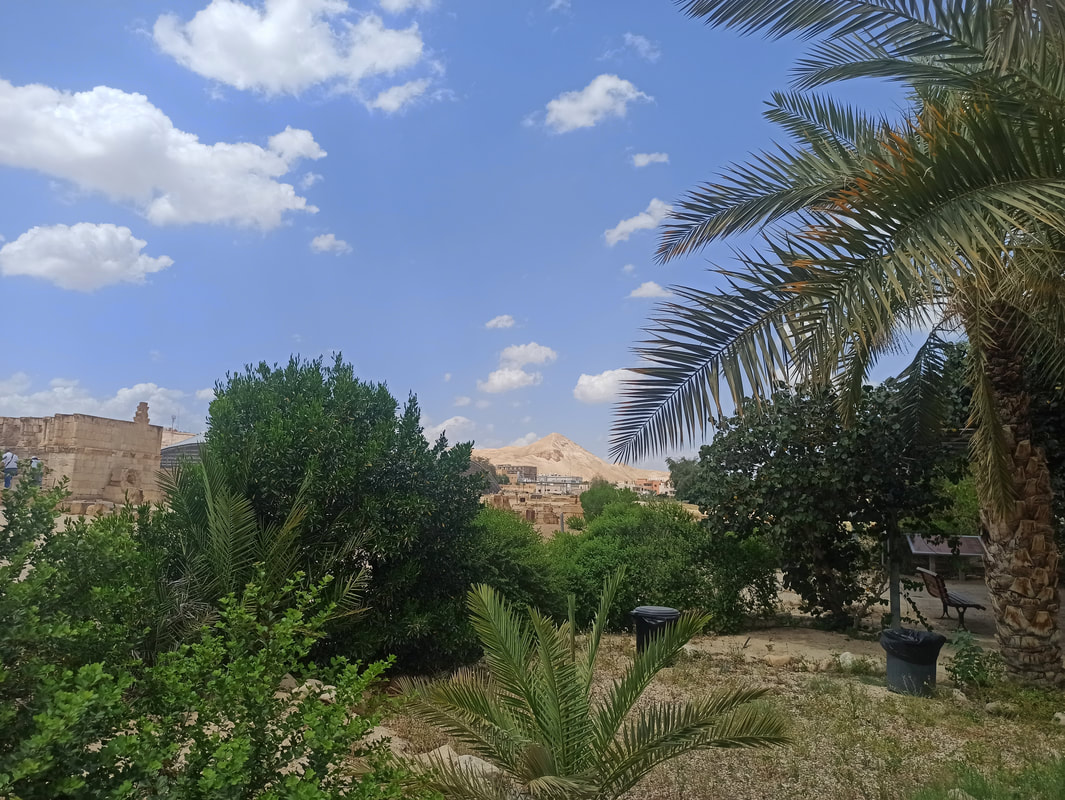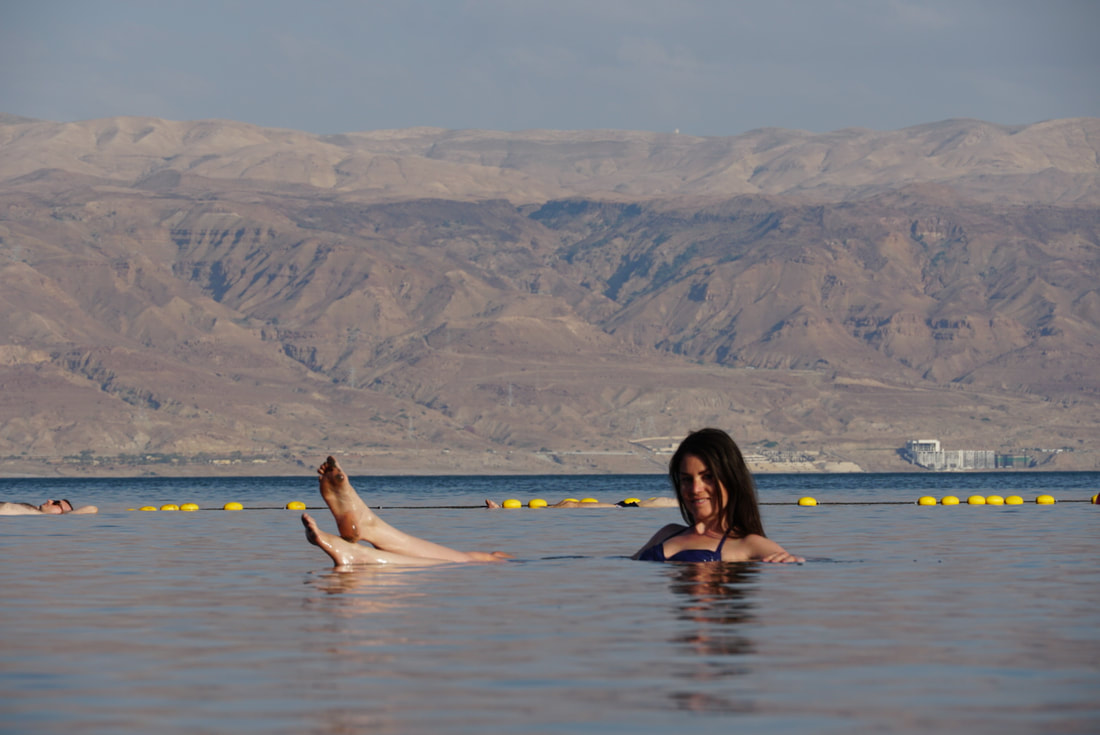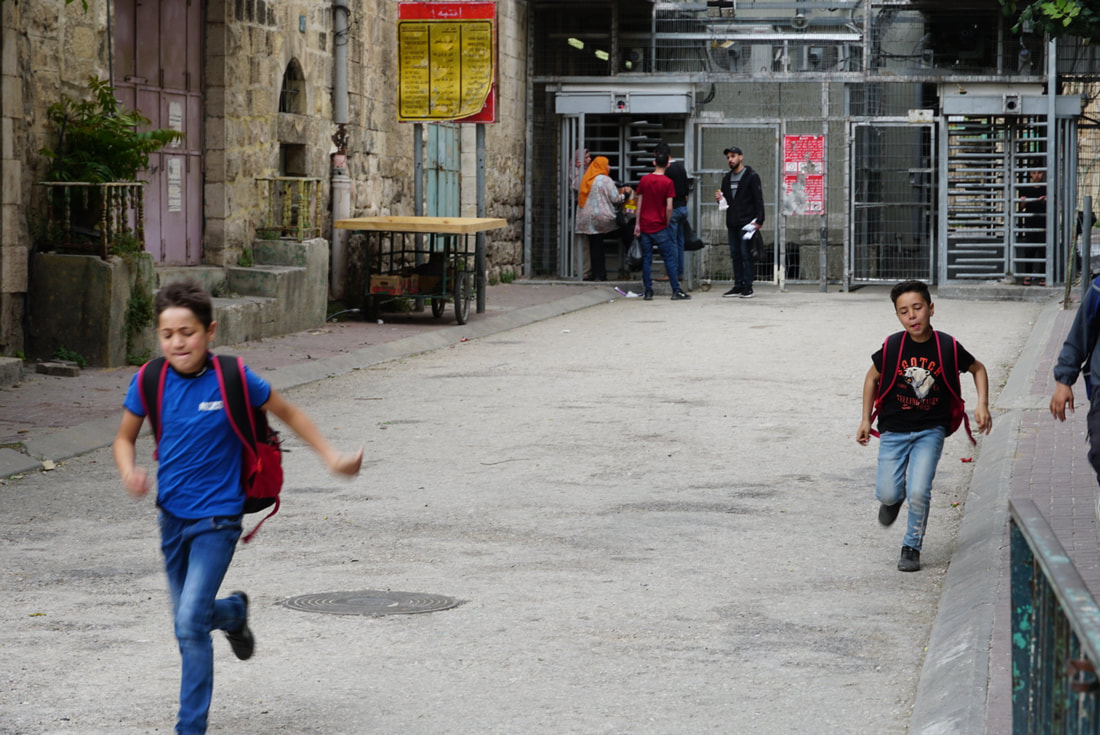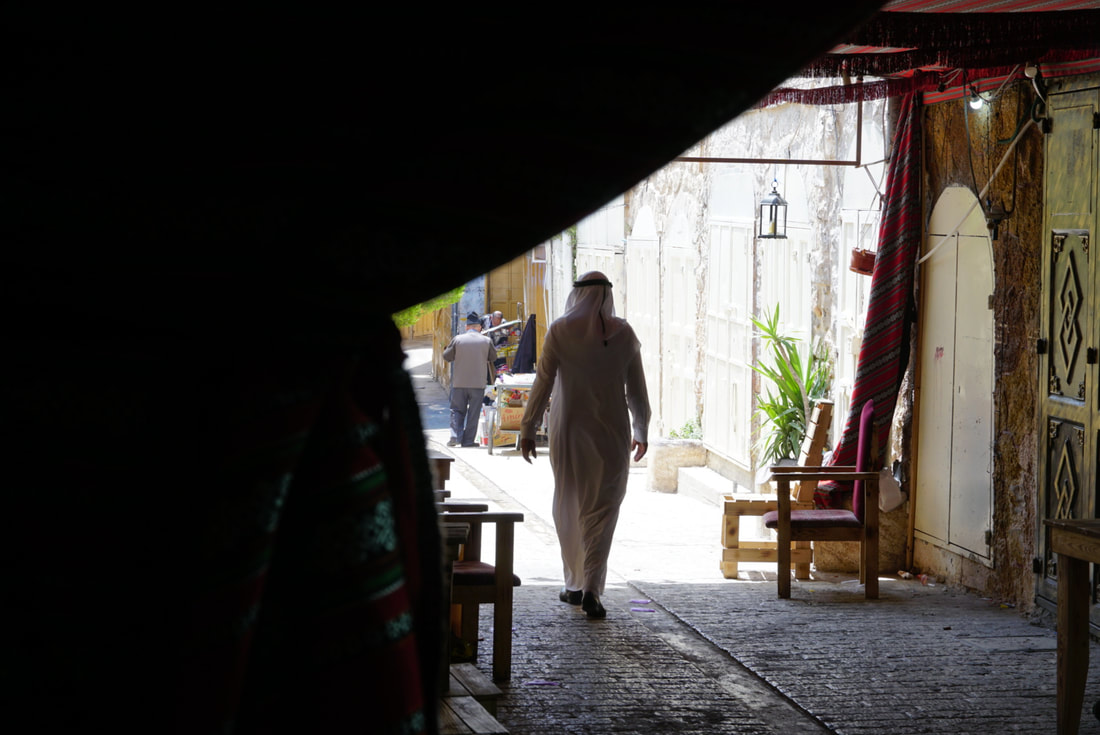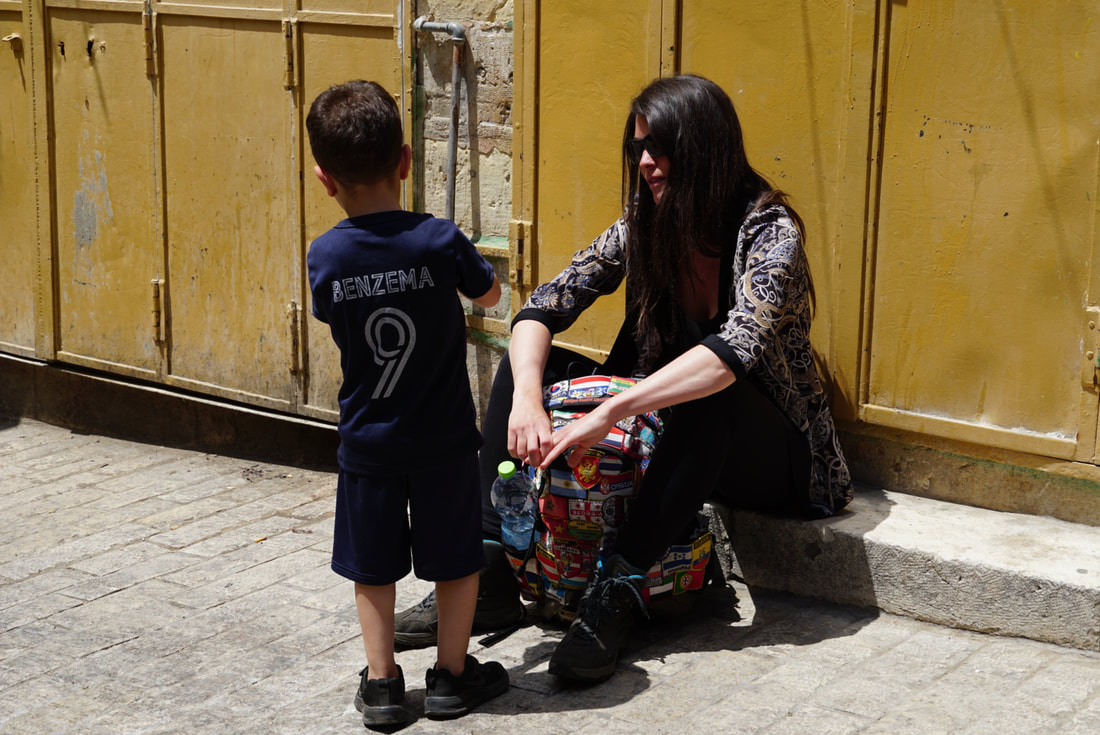West Bank
Not in the story-mood? Scroll down for the Quick Budget Fact Overview: an itemized information summary of the West Bank! ↓
[There is an active war going on between Israel and Palestine. Whereas tourists are not the target group of the attacking parties, safety can’t be guaranteed. Even though the writer of the article also visited during wartime and didn’t experience any life-threatening casualties, it is recommended to verify the current safety situation with locals situated in the areas you intend to visit. This can be done on designated Facebook groups or via the Couchsurfing network. As always, don’t rely on the “information” obtained via mass media or from people who haven’t actually been there themselves. As a weathered traveler, you know the drill.]
[There is an active war going on between Israel and Palestine. Whereas tourists are not the target group of the attacking parties, safety can’t be guaranteed. Even though the writer of the article also visited during wartime and didn’t experience any life-threatening casualties, it is recommended to verify the current safety situation with locals situated in the areas you intend to visit. This can be done on designated Facebook groups or via the Couchsurfing network. As always, don’t rely on the “information” obtained via mass media or from people who haven’t actually been there themselves. As a weathered traveler, you know the drill.]
With all that’s going on on television nowadays it seems like an odd choice: Visiting the West Bank of Palestine. The type of place your mom told you to avoid. “Dark tourism at best.” Allegedly.
Admitted, the local Palestinian population does live a dark day-to-day reality, their basic needs and personal freedom being limited to much less than the bare minimum, while their mere existence is at a constant threat. But isn’t that a reason on its own to pay a visit? To confront yourself with the actual state of affairs? Not out of unworthy and unhealthy motivations to stare at someone else’s misery, but with the intention to peek under the veil created by western media, carefully crafted and tweaked to show you a very specific version of a truth aligning with the political strategy your tax money goes into.
To me this was a good reason indeed. I didn’t only want to be an observer though, I wanted to immerge. So I hitchhiked, Couchsurfed, started respectful conversations… not only with Palestinians, but also with Israeli’s and other initial immigrants. With Jews, with Christians, with Muslims, all eager to speak to this Atheist. All with their own story, their own perspectives, their applied filter. Because in the end people are just people. Very few humans overlap flawlessly with the politics that happened to have shed a shadow on their culture, their education, their family life, the friends they meet and the newspaper and television broadcasts that are shown to them. It has an effect, but those aren’t their primal emotions and rationale. Of course, I am no exception, I am exposed to this as well. Even though my rebellious nature almost automatically sympathizes with the exact opposite of what my government tries to tell me, the unavoidable exposure to mass media makes me side with certain perspectives. This makes traveling so crucial in my life. Not only for mere hedonism and allowing me to live my best life, but it also allows me to “go see for myself” and either confirm what I think or shatter it to pieces. Both are welcome outcomes. Some people prefer to spend their holiday time recording tiktok-videos drinking out of a coconut on a dazzling shoreline and that remains unjudged, we all need an occasional brain freeze… but I prefer Palestine over the Costa Brava all day every day.
Admitted, the local Palestinian population does live a dark day-to-day reality, their basic needs and personal freedom being limited to much less than the bare minimum, while their mere existence is at a constant threat. But isn’t that a reason on its own to pay a visit? To confront yourself with the actual state of affairs? Not out of unworthy and unhealthy motivations to stare at someone else’s misery, but with the intention to peek under the veil created by western media, carefully crafted and tweaked to show you a very specific version of a truth aligning with the political strategy your tax money goes into.
To me this was a good reason indeed. I didn’t only want to be an observer though, I wanted to immerge. So I hitchhiked, Couchsurfed, started respectful conversations… not only with Palestinians, but also with Israeli’s and other initial immigrants. With Jews, with Christians, with Muslims, all eager to speak to this Atheist. All with their own story, their own perspectives, their applied filter. Because in the end people are just people. Very few humans overlap flawlessly with the politics that happened to have shed a shadow on their culture, their education, their family life, the friends they meet and the newspaper and television broadcasts that are shown to them. It has an effect, but those aren’t their primal emotions and rationale. Of course, I am no exception, I am exposed to this as well. Even though my rebellious nature almost automatically sympathizes with the exact opposite of what my government tries to tell me, the unavoidable exposure to mass media makes me side with certain perspectives. This makes traveling so crucial in my life. Not only for mere hedonism and allowing me to live my best life, but it also allows me to “go see for myself” and either confirm what I think or shatter it to pieces. Both are welcome outcomes. Some people prefer to spend their holiday time recording tiktok-videos drinking out of a coconut on a dazzling shoreline and that remains unjudged, we all need an occasional brain freeze… but I prefer Palestine over the Costa Brava all day every day.
Too busy to read now? No problem, save it for later!
Save on Get Pocket | Save in Browser Bookmarks| Save on Instapaper
Save on Get Pocket | Save in Browser Bookmarks| Save on Instapaper
So what exactly went down there?
What are you getting yourself into? Why is everyone losing their marbles over this place? I appreciate the question, I like the kind of people who want to be aware of what happened on the very soil they’re walking on.
The ground, which is now the topic of a dispute between the Palestinians and the new Israeli population, has in fact changed hands on multiple occasions in history, as is the case with almost any place on Earth… but most recently (before shit hit the fan) it belonged to the Ottoman Empire (1517-1917), as did a big chunk of Europe. This all changed after WWI was concluded and the “victors” rewarded themselves by redividing the conquered land, as the Ottomans had sided with the German enemy and therefore belonged to the “big fat losers.” Somehow, the area of Palestine went to the English (hard to let go of imperialist habits), under the flag of the “British Mandate of Palestine.” It didn’t take long before the British foreign minister Balfour promised to establish a “Jewish national home” in the area of the Palestinians, which went into the books as the Balfour Declaration. All nice and swell, but this contradicted a promise that had already been made before that, during WWI. Namely, that the Palestinians would receive an independent and recognized Arab State on that exact same land, in exchange for undertaking the Great Arab Revolt of 1915-1916… an armed uprising performed by the Arab Palestinians that had assisted in defeating the Ottomans (the McMahon-Hussein Correspondence). You can’t promise one thing, let the promised party do all the work, then reap the fruits of their labor, to subsequently stab them in the back, am I right? Or is that just me with my damned integrity? England, of course fully aware of their double promises and potential results of that royal fuck-up, tried to smooth things over by stating that in the process of “the establishment in Palestine of a national home for the Jewish people, it should be clearly understood that nothing should be done which might prejudice the civil and religious rights of existing non-Jewish communities in Palestine.” Spoiler-alert: that’s not what ended up happening.
What are you getting yourself into? Why is everyone losing their marbles over this place? I appreciate the question, I like the kind of people who want to be aware of what happened on the very soil they’re walking on.
The ground, which is now the topic of a dispute between the Palestinians and the new Israeli population, has in fact changed hands on multiple occasions in history, as is the case with almost any place on Earth… but most recently (before shit hit the fan) it belonged to the Ottoman Empire (1517-1917), as did a big chunk of Europe. This all changed after WWI was concluded and the “victors” rewarded themselves by redividing the conquered land, as the Ottomans had sided with the German enemy and therefore belonged to the “big fat losers.” Somehow, the area of Palestine went to the English (hard to let go of imperialist habits), under the flag of the “British Mandate of Palestine.” It didn’t take long before the British foreign minister Balfour promised to establish a “Jewish national home” in the area of the Palestinians, which went into the books as the Balfour Declaration. All nice and swell, but this contradicted a promise that had already been made before that, during WWI. Namely, that the Palestinians would receive an independent and recognized Arab State on that exact same land, in exchange for undertaking the Great Arab Revolt of 1915-1916… an armed uprising performed by the Arab Palestinians that had assisted in defeating the Ottomans (the McMahon-Hussein Correspondence). You can’t promise one thing, let the promised party do all the work, then reap the fruits of their labor, to subsequently stab them in the back, am I right? Or is that just me with my damned integrity? England, of course fully aware of their double promises and potential results of that royal fuck-up, tried to smooth things over by stating that in the process of “the establishment in Palestine of a national home for the Jewish people, it should be clearly understood that nothing should be done which might prejudice the civil and religious rights of existing non-Jewish communities in Palestine.” Spoiler-alert: that’s not what ended up happening.
Photo by Miles Watson Photography
The local Arab population of Palestine, dissatisfied about the neglect of what was promised, clearly expressed their stand on the situation that didn’t favor them in any possible way. It was ignored entirely. Against Palestinian wishes, the British facilitated the Zionist mass immigration movement, causing a major demographic shift in a population that was 89% Arab (by 1922 census), triggering the Great Palestinian Revolt (1936-1939). The British response? Imprisonment without charges or trial, whip lashings, murders, house demolitions and collective punishment. Pure class, as always in the British history. Of course, the rise of Adolf Hitler, which led to the initiation of the Jewish genocide in WWII, gave the Zionist immigration movement an understandable boost. War victims need to be helped. However, as even recognized by Britain, there are more places than just Palestine where they can go to. As the Jewish immigration into Palestine became close to uncontrollable, quotas were introduced and alternative detention camps were created in places such as Mauritius.
In 1937, the first talks to divide Palestine into a Jewish and Arab State took place. A big part of the deal was an envisioned population exchange, similar to what had also happened in the 1920s between Turkey and Greece (which was also an absolute disaster there and then – more info on that in my Thessaloniki blog). A majority of the Palestinians supported the plan, the Zionist leadership found the proposed land that they didn’t even have in the first place too small and declared it was just the first step in their plan to gradually claim entire Palestine (words by Ben Gurion, the former prime minister and current national hero). The Israeli intentions were made clear. In 1947, the Partition Plan for Palestine came into effect under the United Nations, dividing the area into an Arab State (incl. the West Bank), Jewish State and an internationally administered enclave of Jerusalem. The next day, a civil war began.
The local Arab population of Palestine, dissatisfied about the neglect of what was promised, clearly expressed their stand on the situation that didn’t favor them in any possible way. It was ignored entirely. Against Palestinian wishes, the British facilitated the Zionist mass immigration movement, causing a major demographic shift in a population that was 89% Arab (by 1922 census), triggering the Great Palestinian Revolt (1936-1939). The British response? Imprisonment without charges or trial, whip lashings, murders, house demolitions and collective punishment. Pure class, as always in the British history. Of course, the rise of Adolf Hitler, which led to the initiation of the Jewish genocide in WWII, gave the Zionist immigration movement an understandable boost. War victims need to be helped. However, as even recognized by Britain, there are more places than just Palestine where they can go to. As the Jewish immigration into Palestine became close to uncontrollable, quotas were introduced and alternative detention camps were created in places such as Mauritius.
In 1937, the first talks to divide Palestine into a Jewish and Arab State took place. A big part of the deal was an envisioned population exchange, similar to what had also happened in the 1920s between Turkey and Greece (which was also an absolute disaster there and then – more info on that in my Thessaloniki blog). A majority of the Palestinians supported the plan, the Zionist leadership found the proposed land that they didn’t even have in the first place too small and declared it was just the first step in their plan to gradually claim entire Palestine (words by Ben Gurion, the former prime minister and current national hero). The Israeli intentions were made clear. In 1947, the Partition Plan for Palestine came into effect under the United Nations, dividing the area into an Arab State (incl. the West Bank), Jewish State and an internationally administered enclave of Jerusalem. The next day, a civil war began.
Israel ended up keeping the grounds they were already awarded, plus 60% of what was internationally decided to be part of the Arab State (as such, living up to their communicated intentions of warfare and expansion). The West Bank area was annexed and officially named this way by (Trans)Jordan, which was part of the several Arab countries that had aided their Palestinian brothers in their struggle. It remained that way until 1967, when the Six-Day-War (fuelled by the Suez Crisis between Egypt and Israel, and fought out with US weapons as they were worried about the Arab dominance more than anything) caused the West Bank, as well as East Jerusalem, Gaza, Golan Heights and Sinai, to be captured by Israel. A military move condemned by the UN and international politics. Instead of recognised Israeli territory, it is until today still referred to as “occupied territories” by the EU, US, UN, and the International Court of Justice. Even though a full annexation did not happen, the area remained under Israeli military control and they immediately started their strategy of driving Arab Palestinians out of their homes, while setting up Jewish settlements in all occupied areas as a passive way of taking over land and property. Illegally, as International Law / Article 49 of the Fourth Geneva Convention specifically prohibits "transfers of the population of an occupying power to occupied territories.”
How can the Palestinians stay calm while Israel just keeps ignoring all international and lawful agreements, while they’re taking away the very land under their feet? Turns out, they can’t. Would you? From 1987 until 1993, the First Palestinian Intifada, nicknamed the “Stone Uprising” took place, referring to a series of protests and violent riots. As turned out to become a theme in the Palestinian-Israeli interaction, the Palestinians had to pay a disproportionate price as Israel always strikes back with disproportionate violence. Death rates don’t lie:
How can the Palestinians stay calm while Israel just keeps ignoring all international and lawful agreements, while they’re taking away the very land under their feet? Turns out, they can’t. Would you? From 1987 until 1993, the First Palestinian Intifada, nicknamed the “Stone Uprising” took place, referring to a series of protests and violent riots. As turned out to become a theme in the Palestinian-Israeli interaction, the Palestinians had to pay a disproportionate price as Israel always strikes back with disproportionate violence. Death rates don’t lie:
In the First Intifada, 200 Israelis lost their lives opposed to 1,300 Palestinians. Numerous peace agreements were negotiated, including the Oslo Peace Accords and the Gaza-Jericho Agreement, but they remained unsuccessful on the longer term and Palestinians found their situation unchanged. This resulted in the Second Intifada, Al-Aqsa, which was all the more violent (once again claiming a disproportionate amount of Palestinian lives) and resulted in Israel building a wall through the West Bank, cutting Palestinians off from Jerusalem and slicing Palestinian villages in half. A development which was explained as defence by the Israelis, but seen by the Palestinians as another Israeli strategy to grab more land. Conflict grew, hate grew… eventually allowing an organization as Hamas to seize power. An organization thriving on violence, seemingly the last resort for a nation that kept on drawing the shortest straw. A terrorist group that doesn’t help its own people in any way, and only triggers more violence from the Israeli opponent that “retaliates” with a disproportionate number of deaths of civilians. Despite wins such as Palestine’s entry into the UN as a non-member observer state and a de-facto recognition of the sovereign state of Palestine, the bloodshed continued on both sides of the warzone, always resulting in more Palestinian than Israeli deaths.
The use of words such as “retaliation” and “self-defence” depend on what you count as the “beginning” of the conflict. The Intifada’s? Nah, that’s a far-fetched result of something that started way earlier, in 1917. It’s easy to play dumb or suddenly resort to selective memory, but I know you know.
The use of words such as “retaliation” and “self-defence” depend on what you count as the “beginning” of the conflict. The Intifada’s? Nah, that’s a far-fetched result of something that started way earlier, in 1917. It’s easy to play dumb or suddenly resort to selective memory, but I know you know.
Photo by Miles Watson Photography
Getting into the West Bank
… just requires grabbing a bus. An armoured bus, to be more specific, which is standard procedure for cross-territory routes. Yet, you can just use your general Rav Kav Card, which works in both Israeli and Palestinian territory (but only on Israeli buses). Generally, there are no border checks or complications and it’s a pretty straightforward A-to-B endeavour. Within the West Bank, there are additional minibuses that can be paid in cash. Car travel is more troublesome. Entering Palestinian territory with an Israeli number plate or leaving the West Bank in a Palestinian vehicle can cause anything from a mild inconvenience to a grave problem. I experienced this first hand when trying to hitchhike out of Jericho in a Palestinian vehicle… After a 2-hour wait and zero progress (the Palestinians are basically locked up inside of their own city) we literally escaped out of this area through the desert. An experience that will stay with me until the end of days.
Getting into the West Bank
… just requires grabbing a bus. An armoured bus, to be more specific, which is standard procedure for cross-territory routes. Yet, you can just use your general Rav Kav Card, which works in both Israeli and Palestinian territory (but only on Israeli buses). Generally, there are no border checks or complications and it’s a pretty straightforward A-to-B endeavour. Within the West Bank, there are additional minibuses that can be paid in cash. Car travel is more troublesome. Entering Palestinian territory with an Israeli number plate or leaving the West Bank in a Palestinian vehicle can cause anything from a mild inconvenience to a grave problem. I experienced this first hand when trying to hitchhike out of Jericho in a Palestinian vehicle… After a 2-hour wait and zero progress (the Palestinians are basically locked up inside of their own city) we literally escaped out of this area through the desert. An experience that will stay with me until the end of days.
Hebron
There is no bigger example of the day-to-day reality of the Israeli-Palestinian conflict than Hebron, a city that represents both the décor and the interim result of the struggle. A city that is labelled a “microcosm” of the entire Israeli-Palestinian conflict and the Israeli occupation of the West Bank. Here all moments and facets of friction and attempted peace negotiations (described in the history section above) played out on a small scale. If you want to dive into the history of the Israeli-Palestinian collision, Hebron is your first stop.
So off I went. Not alone, as I usually do. To deepen my understanding and “live” this city from both the Israeli and Palestinian points of view, I joined Abraham Tours’ “Dual Narrative Tour”, led partly by a Jewish Israeli and partly by a Muslim Palestinian guide. An inclusive approach (as the Christians, who also have deeply rooted traditions in Hebron, don’t actively participate in attacking one another – for once). While driving passed bus stops which were protected by Israeli soldiers holding machine guns, due to memories of the Second Intifada’s car rammings, I listened to the Rabbi guide holding a microphone. What we see as an occupation, he said, was in fact a liberation. A liberation by the hand of God and a favor to the world! Hmmm alright, coming in strong, I see. A liberation of people who don’t want to be liberated and have death as an alternative, and a favor to the world which by international law is considered as downright illegal. I am all ears.
A city appeared. Hebron. The second largest city in the West Bank, after East Jerusalem, divided in sectors. The bus pulled up in Sector H2, forming roughly 20% of the city and housing ca. 35,000 Palestinians living under Israeli military administration. The first thing I noticed were the infamous Jewish settlements. Condemned and strictly forbidden by the international justice system, but undeniably standing there defying all law and legislation. “You face life long prison or even execution if you sell properties to Jews, but this is often the only way for Palestinians to financially survive, “ Mr. Rabbi informed us. “… the only way to financially survive after being cut off from their natural and financial resources,” he forgot to add, but maybe that’s not his part of the “narrative” in this Dual Narrative Tour. I noticed the rather large tour group eyeing each other. Everyone came in as neutral as their conscience would allow, but they were already being challenged.
There is no bigger example of the day-to-day reality of the Israeli-Palestinian conflict than Hebron, a city that represents both the décor and the interim result of the struggle. A city that is labelled a “microcosm” of the entire Israeli-Palestinian conflict and the Israeli occupation of the West Bank. Here all moments and facets of friction and attempted peace negotiations (described in the history section above) played out on a small scale. If you want to dive into the history of the Israeli-Palestinian collision, Hebron is your first stop.
So off I went. Not alone, as I usually do. To deepen my understanding and “live” this city from both the Israeli and Palestinian points of view, I joined Abraham Tours’ “Dual Narrative Tour”, led partly by a Jewish Israeli and partly by a Muslim Palestinian guide. An inclusive approach (as the Christians, who also have deeply rooted traditions in Hebron, don’t actively participate in attacking one another – for once). While driving passed bus stops which were protected by Israeli soldiers holding machine guns, due to memories of the Second Intifada’s car rammings, I listened to the Rabbi guide holding a microphone. What we see as an occupation, he said, was in fact a liberation. A liberation by the hand of God and a favor to the world! Hmmm alright, coming in strong, I see. A liberation of people who don’t want to be liberated and have death as an alternative, and a favor to the world which by international law is considered as downright illegal. I am all ears.
A city appeared. Hebron. The second largest city in the West Bank, after East Jerusalem, divided in sectors. The bus pulled up in Sector H2, forming roughly 20% of the city and housing ca. 35,000 Palestinians living under Israeli military administration. The first thing I noticed were the infamous Jewish settlements. Condemned and strictly forbidden by the international justice system, but undeniably standing there defying all law and legislation. “You face life long prison or even execution if you sell properties to Jews, but this is often the only way for Palestinians to financially survive, “ Mr. Rabbi informed us. “… the only way to financially survive after being cut off from their natural and financial resources,” he forgot to add, but maybe that’s not his part of the “narrative” in this Dual Narrative Tour. I noticed the rather large tour group eyeing each other. Everyone came in as neutral as their conscience would allow, but they were already being challenged.
Photos by Miles Watson Photography
First stop: the heart of Hebron, the Cave of Patriarchs. The main sight that put Hebron on the map and provides its prime right of existence, as well as the source of all struggle. A place we would visit twice that day, once from the Jewish entrance with all men of the tour wearing a yamaka, once from the Islamic entrance when all ladies got equipped with a Harry-Potter’esque purple robe covering head and body. A key location in the Jewish, Islamic and Christian traditions as the burial site of the patriarchs Abraham, Isaac and Jacob, along with their wives Sarah, Rebecca and Leah. The burial cave is currently closed as to avoid conflict between the three religions… which is, of course, a futile measurement. It always has been and always will be a source of struggle, and has resulted in several events labelled as a “massacre” performed and received by both Muslims and Jews (the latest one carried out by a far-right Zionist who opened fire on Palestinian Muslims in prayer – resulting in a current situation of Israeli soldiers “protecting” the building, how ironic). As long as this cave has been known to exist, the three religions have played musical chairs around it, transforming the holy house on its location into a synagogue, a church or a mosque due to whatever direction the political wind was blowing. As such, it’s rather easy for all three of ‘em to find proof of why the place belongs to them, as in one historical timeline or the other, it indeed did. The Jewish claim refers to Abraham’s purchase of the cave from the previous Hittites population, making it allegedly their first “real estate.” “All religions have the paperwork to proof it, coming from different layers of history. We're both right and both wrong. And that's why it's so complex”, our guide rightfully stated. Standing on these controversial grounds, right in front of Abraham’s assumed tomb who died at (drum roll) the age of 175, is unreal. Literally, or figuratively, depending on your (non-)religious background.
First stop: the heart of Hebron, the Cave of Patriarchs. The main sight that put Hebron on the map and provides its prime right of existence, as well as the source of all struggle. A place we would visit twice that day, once from the Jewish entrance with all men of the tour wearing a yamaka, once from the Islamic entrance when all ladies got equipped with a Harry-Potter’esque purple robe covering head and body. A key location in the Jewish, Islamic and Christian traditions as the burial site of the patriarchs Abraham, Isaac and Jacob, along with their wives Sarah, Rebecca and Leah. The burial cave is currently closed as to avoid conflict between the three religions… which is, of course, a futile measurement. It always has been and always will be a source of struggle, and has resulted in several events labelled as a “massacre” performed and received by both Muslims and Jews (the latest one carried out by a far-right Zionist who opened fire on Palestinian Muslims in prayer – resulting in a current situation of Israeli soldiers “protecting” the building, how ironic). As long as this cave has been known to exist, the three religions have played musical chairs around it, transforming the holy house on its location into a synagogue, a church or a mosque due to whatever direction the political wind was blowing. As such, it’s rather easy for all three of ‘em to find proof of why the place belongs to them, as in one historical timeline or the other, it indeed did. The Jewish claim refers to Abraham’s purchase of the cave from the previous Hittites population, making it allegedly their first “real estate.” “All religions have the paperwork to proof it, coming from different layers of history. We're both right and both wrong. And that's why it's so complex”, our guide rightfully stated. Standing on these controversial grounds, right in front of Abraham’s assumed tomb who died at (drum roll) the age of 175, is unreal. Literally, or figuratively, depending on your (non-)religious background.
We continued onwards on the Beer Sheva Road. A dangerous road, serving as one of the main backdrops of the armed conflict. Stones where thrown here at Israeli soldiers, the Rabbi informed… which were responded to with the bullets and tear gas cannisters I found lying on the street. Remember that “disproportionate” was the key word? We passed the market, stocked to the brim with vegetables and knick-knacks against the backdrop of the bustling chants of vendors, random elements forming one of the many fibres in the complex embroidery that defines Arab culture… Here we were handed over to our Palestinian guide. Also she had a way of breaking the ice: “England said they would give ‘a land with no people’ to ‘the people with no land’, but they forgot to notice that the land was in fact already filled with Palestinians. Aren’t we people? By the way we are treated, they indeed seem to think we are not.” Silence.
We followed her through the streets which form her home. For now. We’ve all seen the videos of the violent removals of civilians out of their family homes. Facts. Actual events. Which made me realise that what I’ve heard so far today were all religious arguments. Sure, they might be facts to our Rabbi, and he is entitled to believe any of those in full freedom. Yet, it’s not universal. Our Muslim guide, while of course providing background information on the Islamic narrative behind all sights and buildings, did not use anything out of the Quran as actual “proof” or justification of the current situation. While she was sticking to her own narrative based on real-life events, I could only hear our other guide defending himself. A reaction on the opposing narrative. I listened to the young woman in hijab standing in front of us, telling the story that I already knew, but coming out of the mouth of someone who actually lived it. Standing among the buildings where it all happened. Places I have seen in the news, but now I was breathing the very air of. We visited the Palestinian Information Centre, as well as the Hebron Jewish Museum, preserving the two narratives behind a glass showcase.
... but it was there, standing under the protection screens on top of those gated streets, stepping over the bullets that either mark a death or a narrow escape, with the dry dust of a former and future battlefield on my shoes, that I felt it. The arbitrary history, the clash of nations… the dual narrative.
After an intense, but worthy day and valuable tour we made our way back to the bus. Gunshots fired in the background. The Rabbi smiled at our shocked faces: “Not a big deal.” It is. It might be common, but that doesn’t make it not a big deal. It might be the sound of someone’s death, and whether that was an Israeli or a Palestinian, it was a human life that counted. Indifference or the inability to recognize the importance of another human life lost is what keeps any solution or road to peace at bay. A depressing conclusion of a confronting day.
We followed her through the streets which form her home. For now. We’ve all seen the videos of the violent removals of civilians out of their family homes. Facts. Actual events. Which made me realise that what I’ve heard so far today were all religious arguments. Sure, they might be facts to our Rabbi, and he is entitled to believe any of those in full freedom. Yet, it’s not universal. Our Muslim guide, while of course providing background information on the Islamic narrative behind all sights and buildings, did not use anything out of the Quran as actual “proof” or justification of the current situation. While she was sticking to her own narrative based on real-life events, I could only hear our other guide defending himself. A reaction on the opposing narrative. I listened to the young woman in hijab standing in front of us, telling the story that I already knew, but coming out of the mouth of someone who actually lived it. Standing among the buildings where it all happened. Places I have seen in the news, but now I was breathing the very air of. We visited the Palestinian Information Centre, as well as the Hebron Jewish Museum, preserving the two narratives behind a glass showcase.
... but it was there, standing under the protection screens on top of those gated streets, stepping over the bullets that either mark a death or a narrow escape, with the dry dust of a former and future battlefield on my shoes, that I felt it. The arbitrary history, the clash of nations… the dual narrative.
After an intense, but worthy day and valuable tour we made our way back to the bus. Gunshots fired in the background. The Rabbi smiled at our shocked faces: “Not a big deal.” It is. It might be common, but that doesn’t make it not a big deal. It might be the sound of someone’s death, and whether that was an Israeli or a Palestinian, it was a human life that counted. Indifference or the inability to recognize the importance of another human life lost is what keeps any solution or road to peace at bay. A depressing conclusion of a confronting day.
Bethlehem
Let’s go to Bethlehem. Wait… what? You mean, where-jesus-is-born-bethlehem, the nativity-scene-bethlehem?! Yes, I’m being serious. This place on Earth is quite a ridiculous destination, in the most positive sense of the word. So indeed, the first point on the sightseeing-checklist is most probably the Nativity Cave, where needless to say a church is built around (the Church of the Nativity). Don’t plan this too tight, as you’re about to join a long line of Christians waiting to get in, blended with the occasional Atheist here and there (me) eager to be able to say they’ve been here. If you’re going balls deep, you might as well check off Rachel’s Tomb, the Chapel of the Shepherd’s Field (where angels announced Jesus’ birth to the shepherds) and the Milk Grotto Church (turned white by Virgin Mary’s breast milk).
Let’s go to Bethlehem. Wait… what? You mean, where-jesus-is-born-bethlehem, the nativity-scene-bethlehem?! Yes, I’m being serious. This place on Earth is quite a ridiculous destination, in the most positive sense of the word. So indeed, the first point on the sightseeing-checklist is most probably the Nativity Cave, where needless to say a church is built around (the Church of the Nativity). Don’t plan this too tight, as you’re about to join a long line of Christians waiting to get in, blended with the occasional Atheist here and there (me) eager to be able to say they’ve been here. If you’re going balls deep, you might as well check off Rachel’s Tomb, the Chapel of the Shepherd’s Field (where angels announced Jesus’ birth to the shepherds) and the Milk Grotto Church (turned white by Virgin Mary’s breast milk).
Photos by Miles Watson Photography
Then, when you got that out of your system, let’s get ready for some Palestinian experience. Because unlike your probable expectations, Bethlehem is actually situated in the West Bank and therefore has an overall Arabic vibe with a 90% Muslim population. Sights such as the Mosque of Omar, the Al-Bad Olive Pressing Museum and the central souk-style market effortlessly blend in with all the biblical heritage. Of course, confronting yourself with the reality of Palestine, at any location, never is always just an easy-breezy tourist-day-in-the-park. You’re going to see some pain. I just told you about the wall Israel built through the West Bank in the midst of the second Intifada, cutting right through some Palestinian villages and preventing them to go to work, school, or access healthcare… The wall that Israeli’s explain as a way to stop suicide bombers to reach them, but one that Palestinians interpreted as yet another way to illegally occupy land and as an element of racial segregation. Well, that wall still stands in Bethlehem as a concrete proof of a century-long conflict.
The wall itself has become a canvas of street artists alike. Including one you have most definitely heard about: Banksy. Yes, that one who painted the guy throwing flowers instead of a grenade, and the girl with the heart balloon… one of his many iconic illustrations that can all be found here in the West Bank, in and around Bethlehem.
Here you can find the exact locations of the Banksy artworks.
Then, when you got that out of your system, let’s get ready for some Palestinian experience. Because unlike your probable expectations, Bethlehem is actually situated in the West Bank and therefore has an overall Arabic vibe with a 90% Muslim population. Sights such as the Mosque of Omar, the Al-Bad Olive Pressing Museum and the central souk-style market effortlessly blend in with all the biblical heritage. Of course, confronting yourself with the reality of Palestine, at any location, never is always just an easy-breezy tourist-day-in-the-park. You’re going to see some pain. I just told you about the wall Israel built through the West Bank in the midst of the second Intifada, cutting right through some Palestinian villages and preventing them to go to work, school, or access healthcare… The wall that Israeli’s explain as a way to stop suicide bombers to reach them, but one that Palestinians interpreted as yet another way to illegally occupy land and as an element of racial segregation. Well, that wall still stands in Bethlehem as a concrete proof of a century-long conflict.
The wall itself has become a canvas of street artists alike. Including one you have most definitely heard about: Banksy. Yes, that one who painted the guy throwing flowers instead of a grenade, and the girl with the heart balloon… one of his many iconic illustrations that can all be found here in the West Bank, in and around Bethlehem.
Here you can find the exact locations of the Banksy artworks.
To dive deeper into the history around the West Bank Wall and the Palestinian conflict, it’s possible to visit the Palestinian Conflict Transformation Center or the information centre in the Aida Camp, a Palestinian refugee camp. Yet, even though I generally refrain from tours, I felt like I would have appreciated a guide pointing out the different visible elements tied to the conflict, which I was now probably entirely overseeing.
Jericho
You can’t visit the West Bank and skip one of its most prominent cities: Jericho, tucked into the Jordan Valley with the River Jordan to the east and Jerusalem to the west. Labelled “the world’s oldest city” (with settlements dating back to 9000BC), and as such, deserving of a UNESCO World Heritage title. It makes an appearance in the Bible as well, as most places here, being referred to the “city of palm trees.” A correct observation:
You can’t visit the West Bank and skip one of its most prominent cities: Jericho, tucked into the Jordan Valley with the River Jordan to the east and Jerusalem to the west. Labelled “the world’s oldest city” (with settlements dating back to 9000BC), and as such, deserving of a UNESCO World Heritage title. It makes an appearance in the Bible as well, as most places here, being referred to the “city of palm trees.” A correct observation:
I decided to stay the night… without actually realising that I booked a hostel in a refugee camp. A place that is, at the time of writing, under attack. Honestly, it was a rather confronting experience, enabling me to first-hand see and be subjected to the conditions in which people are forced to live here. The fact that the Israeli military wouldn’t let any Palestinian car out of their town (I was inside one of them) and after 2 hours I joined my Palestinian mates in their car-escape through the desert, completed the rather tragic adventure.
The UNESCO World Heritage Site consists of the archaeological remains of the planet’s oldest city, currently named Tell es-Sultan, or simpler, Old Jericho. However, I would like to bring another impressive sight to your attention: the Hisham Palace, one of the Umayyad Dynasty’s “desert castles” erected in the 8th century. What makes this site extra special are the recently restored mosaics in the former bathing house, a 12-mln-dollar and multi-year Japanese-funded project resulting in a currently immaculate condition of this worthy sight. The kaleidoscopic designs constructed out of natural stones in 21 different colors take up over 836 square meters, which makes it the largest floor mosaic in the Middle East and also one of the biggest worldwide.
The UNESCO World Heritage Site consists of the archaeological remains of the planet’s oldest city, currently named Tell es-Sultan, or simpler, Old Jericho. However, I would like to bring another impressive sight to your attention: the Hisham Palace, one of the Umayyad Dynasty’s “desert castles” erected in the 8th century. What makes this site extra special are the recently restored mosaics in the former bathing house, a 12-mln-dollar and multi-year Japanese-funded project resulting in a currently immaculate condition of this worthy sight. The kaleidoscopic designs constructed out of natural stones in 21 different colors take up over 836 square meters, which makes it the largest floor mosaic in the Middle East and also one of the biggest worldwide.
Dead Sea
A famous Israeli sight, but one that is in fact predominantly Palestinian (or entirely Palestinian, depending on your personal definition) and mostly located in the West Bank and Jordan, is the Dead Sea. A sea that isn’t a sea, but in fact a salt water lake. Unlike popular believe, it is not the saltiest body of water in the world. That title goes to Gaet’ale Pond in Ethiopia (and in fact, Lake Elton in Russia, Lake Retba in Senegal, Garabogazköl Lagoon in Turkmenistan, Lake Assal in Djibouti and the Don Juan Pond in Antarctica all exceed the Dead Sea in saltiness). Yet, it is 9.6 times saltier than the ocean, and the density is so strong that swimming is impossible. Instead, you float, which is a fun activity everyone wants to see him/herself doing once in a lifetime. It is also the world’s lowest lake, and if you walk on the shores around it, you can also assure yourself you walked on the lowest land-based elevation on Planet Earth – self-high-five.
A famous Israeli sight, but one that is in fact predominantly Palestinian (or entirely Palestinian, depending on your personal definition) and mostly located in the West Bank and Jordan, is the Dead Sea. A sea that isn’t a sea, but in fact a salt water lake. Unlike popular believe, it is not the saltiest body of water in the world. That title goes to Gaet’ale Pond in Ethiopia (and in fact, Lake Elton in Russia, Lake Retba in Senegal, Garabogazköl Lagoon in Turkmenistan, Lake Assal in Djibouti and the Don Juan Pond in Antarctica all exceed the Dead Sea in saltiness). Yet, it is 9.6 times saltier than the ocean, and the density is so strong that swimming is impossible. Instead, you float, which is a fun activity everyone wants to see him/herself doing once in a lifetime. It is also the world’s lowest lake, and if you walk on the shores around it, you can also assure yourself you walked on the lowest land-based elevation on Planet Earth – self-high-five.
Photo by Miles Watson Photography
It's an easy place to get to by public transport. From Jerusalem, just take bus #486 towards the Masada Junction if you want to go to the commercialized Kalia Beach, or stay seated if you want to continue to other stops such as Ein Gedi or Ein Bokek. I visited the free Ein Bokek one first, but learned the hard wat that many public beaches have disappeared. I still managed to hike to the shore to go for a dip, but this was a sobering experience. Not only did I rip my toes open on the many sharp salt crusts, I also endangered my own life by hiking in the blistering desert heat of 45-50 degrees Celsius without a single slither of shade… causing the first worrying signs of dehydration (unfortunately, I am not exaggerating). There are other dangers I dodged, such as flooding and the increasing amount of sink holes the shore is dotted with, which also makes wild camping a risky business. That said, the scenery, with the Masada Mountains rising up in the background, is unlevelled. Nevertheless, I honestly recommend just digging up those few shekels to go to the privatized Kalia Beach, closest to Jerusalem, or one of the resorts in Ein Bokek. I did, eventually, and had a less secluded, but much more laidback experience there. Not to mention the convenience of a shower, which you will want. You’ll be able to set down your bathing suit like a statue afterwards, imagine the feeling on your skin.
Fun (?) fact: For the first time in my life, I spotted a hyena in the wild, close to Kalia Beach! First I figured I must be mistaken… but no, Google informed me that there is indeed a striped hyena population to be found in this region, but it is very rare to spot one. (Un)lucky me!
It's an easy place to get to by public transport. From Jerusalem, just take bus #486 towards the Masada Junction if you want to go to the commercialized Kalia Beach, or stay seated if you want to continue to other stops such as Ein Gedi or Ein Bokek. I visited the free Ein Bokek one first, but learned the hard wat that many public beaches have disappeared. I still managed to hike to the shore to go for a dip, but this was a sobering experience. Not only did I rip my toes open on the many sharp salt crusts, I also endangered my own life by hiking in the blistering desert heat of 45-50 degrees Celsius without a single slither of shade… causing the first worrying signs of dehydration (unfortunately, I am not exaggerating). There are other dangers I dodged, such as flooding and the increasing amount of sink holes the shore is dotted with, which also makes wild camping a risky business. That said, the scenery, with the Masada Mountains rising up in the background, is unlevelled. Nevertheless, I honestly recommend just digging up those few shekels to go to the privatized Kalia Beach, closest to Jerusalem, or one of the resorts in Ein Bokek. I did, eventually, and had a less secluded, but much more laidback experience there. Not to mention the convenience of a shower, which you will want. You’ll be able to set down your bathing suit like a statue afterwards, imagine the feeling on your skin.
Fun (?) fact: For the first time in my life, I spotted a hyena in the wild, close to Kalia Beach! First I figured I must be mistaken… but no, Google informed me that there is indeed a striped hyena population to be found in this region, but it is very rare to spot one. (Un)lucky me!
A more cultural outing can be obtained by visiting the discovery location of the Dead Sea Scrolls, which are the original holy writings (in Hebrew) of almost all books from the Old Testament (all, except of the Book of Esther). While they are currently showcased in the Shrine of the Book in the Israel Museum in Jerusalem and partly in the Jordan Museum in Amman, their discovery place is the Qumran Caves collection near the banks of the Dead Sea, which is open to visitors.
Other West Bank Destinations: Ramallah, Nablus and Jenin
I had to move on due to time restraints*, but if I would have the unlimited time on my hands I usually have I wouldn’t have stopped there. The West Bank has more key destinations worth exploring, such as Ramallah, the de-facto capital of Palestine while Jerusalem can’t take that position. A city that was not only subjected to the entire Israel-Palestine struggle, with all its visible marks to show for it, but one that currently also houses museums and cultural centres, and boasts a lively nightlife scene. Nablus is Palestine’s main university town, with the An-Najah National University at its very heart. Jenin is mainly known for its refugee camp, which has been a stronghold of the Israeli military since it came into existence. Currently, it is an unsafe place to visit, as it’s actively under attack.
* I was working a fulltime seasonal job in Switzerland to fund all of these adventures, as this blog isn’t commercial enough to financially survive on, even though the time spent on it almost equals a fulltime job… blinks eyes in innocence why pointing it the donation at the end of this page ↓↓↓
Other West Bank Destinations: Ramallah, Nablus and Jenin
I had to move on due to time restraints*, but if I would have the unlimited time on my hands I usually have I wouldn’t have stopped there. The West Bank has more key destinations worth exploring, such as Ramallah, the de-facto capital of Palestine while Jerusalem can’t take that position. A city that was not only subjected to the entire Israel-Palestine struggle, with all its visible marks to show for it, but one that currently also houses museums and cultural centres, and boasts a lively nightlife scene. Nablus is Palestine’s main university town, with the An-Najah National University at its very heart. Jenin is mainly known for its refugee camp, which has been a stronghold of the Israeli military since it came into existence. Currently, it is an unsafe place to visit, as it’s actively under attack.
* I was working a fulltime seasonal job in Switzerland to fund all of these adventures, as this blog isn’t commercial enough to financially survive on, even though the time spent on it almost equals a fulltime job… blinks eyes in innocence why pointing it the donation at the end of this page ↓↓↓
Quick Budget Fact Overview
Palestine/Israel Facts
Short History Recap (at least, as short as possible for a place like this)
1917: UK seizes Palestine from Ottomans. Balfour Declaration: UK gives support to "national home for the Jewish people" in Palestine. ’20: San Remo Allied Powers conference grants Palestine to Britain as mandate, to prepare for self-rule. Jewish immigration continues. ’22: UK separates Transjordan from Mandate Palestine, forbids Jewish settlement in Transjordan. ’39: UK White Paper limits Jewish migration to Palestine to 10,000 per year. ‘40s: Nazi Holocaust → Jewish mass migration. Jewish armed groups fight for independent Jewish state. ’47: UN recommends partition of Palestine into separate Jewish and Arab states. ’48: Israel declares independence as British mandate ends → admitted to UN. ‘48-’49: 1st Arab-Israeli War, Palestinians driven out of their homes. Armistice agreements give Israel more territory than planned under Partition Plan. Jordan annexes West Bank and eastern Jerusalem. Egypt occupies Gaza. Around 750,000 Palestinian Arabs either flee/expelled. ‘56-’57: Suez Crisis → Israel & UK/France plan to invade Egypt to re-open canal to Israeli shipping. UN buffer force set up in Sinai and Gaza, Israeli shipping allowed. ’57: Israel & France begin to build a large nuclear reactor in Negev Desert → basis for unconfirmed nuclear weapons programme. ’62: Concerns about the Middle Eastern balance of power prompts US to sell Israel missiles + France provides arms supplies to Israel in ’66. ’64: National Water Carrier brings water from Jordan River to Negev → tensions with Arabs. ’67: Six Day War → Israel launches attack on Egypt → Jordan and Syria join war. War leaves Israel in control of east Jerusalem, West Bank, Gaza, Golan Heights and Sinai. Jewish settlements are set up in all of these areas. ’72: Black September → Palestinian gunmen take the Israeli team hostage at the Munich Olympics. 2 athletes murdered, 9 killed during failed rescue attempt. ’73: Egypt & Syria launch attack against Israeli forces in occupied Sinai & Golan Heights (Yom Kippur / October War) → Israel prevails. ’74: Gush Emunim movement formed to promote Jewish religious settlements on West Bank. ’76: Land Day → 6 Arabs killed by mass protests against government attempts to expropriate land in the Galilee area of northern Israel. ’81: Israeli Force raid destroys nuclear reactor at Osirak in Iraq. ’82: Israel invades Lebanon to expel Palestine Liberation Organisation (PLO) leadership after assassination attempt by small Palestinian militant group on Israeli ambassador. ’82: Massacre of Palestinians in the Sabra and Shatila camps in Beirut. ’85: Introducing Israeli Shekel to beat hyperinflation. ’85: Israel withdraws from most of Lebanon but continues to occupy narrow "security zone" along border. ’87: First Intifada uprising begins in Occupied Territories. Muslim Brotherhood in Gaza forms Hamas movement → violence against Israel. ’90: Soviet Union allows Jews to emigrate, leading to about a million ex-Soviet citizens moving to Israel. ’91: Gulf War → Iraq fires 39 missiles at Israel in failed attempt to regionalise conflict. Israel refrains from responding at US request. ’93: Oslo Declaration for Palestinian self-government. ’94: Israel withdraws from most of Gaza and Jericho. ’94: Jordan & Israel sign peace treaty. Yitzhak Rabin, Yasser Arafat and Israeli Foreign Minister Shimon Peres jointly awarded Nobel Peace Prize. ’95: Jewish extremist shoots Yitzhak Rabin dead in Tel Aviv. 2000: Israel withdraws from southern Lebanon. ’02: Israeli army launches Operation Defensive Shield on West Bank after Palestinian suicide bombings. Israel begins building barrier in and around West Bank = interpreted as defence by Israelis, but as a way to grab more land by Palestinians. US, EU, Russia & UN propose road map to resolve Israeli-Palestinian conflict, proposing independent Palestinian state. Israel & Palestinian National Authority both accept plan, which requires freeze on West Bank Jewish settlements and an end to attacks on Israelis. ’04: International Court of Justice issues advisory opinion that West Bank barrier is illegal. ’05: Israel withdraws all Jewish settlers and military personnel from Gaza, while retaining control over airspace, coastal waters & border crossings. Hamas wins Palestinian parliamentary elections → rocket attacks on Israel from Gaza escalate + frequent Israeli raids. ’06: Second Lebanon War. ’08: Israel Gaza invasion. ’09: Discovery of major offshore natural gas deposits. ’11: Hamas release Israeli soldier Gilad Shalit in exchange for 1,027 prisoners. ’14: Military campaign Gaza. ’15: Wave of shootings, stabbings and car-rammings by Palestinians or Israeli Arabs. ’16: US military aid package. ’17: Parliament passes a law which retroactively legalises dozens of Jewish settlements built on private Palestinian land in the West Bank. UNESCO votes to declare the Old City of Hebron a Palestinian World Heritage site. ’17: US President Trump recognises Jerusalem as the capital of Israel, upsetting the Arab world and some Western allies. Then he recognised Israeli sovereignty over the Golan Heights, which Israel seized from Syria in the 1967 war and later annexed. The international community does not recognise Israeli sovereignty. ’18: UN and Egypt attempt to broker a long-term ceasefire between Israel and Hamas. ’19: US no longer considers Israeli settlements on the West Bank to be illegal. ’20: United Arab Emirates 1st Gulf state to establish diplomatic relations with Israel. ’21: Forced evictions of Palestinians in east Jerusalem. ’23: War fires up again, Israel initiates genocide of Palestinians.
Palestine/Israel Facts
- Capital: Jerusalem (Ramallah is Palestine’s de facto capital during the occupation)
- Language: Hebrew / Arabic
- Population: ± 9.3 mln Israel / 3 mln West Bank / 590,500 Gaza (Nazareth: 77,445) – the population numbers especially in the Palestinian areas are very flexible, due to the ongoing genocide)
- Sq km: ± 22,145 Israel / 5,860 West Bank / 365 Gaza (Nazareth: ± 16.5)
- Currency: Shekel (₪ - NIS)
- Electricity Outlet: C + H / 230 V / 50 Hz. Check here.
- Country Code Phone: +972
- Emergency Phone: 112 (general), 100 (police), 101 (ambulance), 102 (fire)
- Visa: Find more info about visas for Israel on this page. Unless you’re Israeli, you can enter the West Bank without any issues. More info for an easy visa application here.
- Vaccinations: None
- Climate: Hot Summer Mediterranean Climate (Csa)
- High season: June – September (also really hot)
Short History Recap (at least, as short as possible for a place like this)
1917: UK seizes Palestine from Ottomans. Balfour Declaration: UK gives support to "national home for the Jewish people" in Palestine. ’20: San Remo Allied Powers conference grants Palestine to Britain as mandate, to prepare for self-rule. Jewish immigration continues. ’22: UK separates Transjordan from Mandate Palestine, forbids Jewish settlement in Transjordan. ’39: UK White Paper limits Jewish migration to Palestine to 10,000 per year. ‘40s: Nazi Holocaust → Jewish mass migration. Jewish armed groups fight for independent Jewish state. ’47: UN recommends partition of Palestine into separate Jewish and Arab states. ’48: Israel declares independence as British mandate ends → admitted to UN. ‘48-’49: 1st Arab-Israeli War, Palestinians driven out of their homes. Armistice agreements give Israel more territory than planned under Partition Plan. Jordan annexes West Bank and eastern Jerusalem. Egypt occupies Gaza. Around 750,000 Palestinian Arabs either flee/expelled. ‘56-’57: Suez Crisis → Israel & UK/France plan to invade Egypt to re-open canal to Israeli shipping. UN buffer force set up in Sinai and Gaza, Israeli shipping allowed. ’57: Israel & France begin to build a large nuclear reactor in Negev Desert → basis for unconfirmed nuclear weapons programme. ’62: Concerns about the Middle Eastern balance of power prompts US to sell Israel missiles + France provides arms supplies to Israel in ’66. ’64: National Water Carrier brings water from Jordan River to Negev → tensions with Arabs. ’67: Six Day War → Israel launches attack on Egypt → Jordan and Syria join war. War leaves Israel in control of east Jerusalem, West Bank, Gaza, Golan Heights and Sinai. Jewish settlements are set up in all of these areas. ’72: Black September → Palestinian gunmen take the Israeli team hostage at the Munich Olympics. 2 athletes murdered, 9 killed during failed rescue attempt. ’73: Egypt & Syria launch attack against Israeli forces in occupied Sinai & Golan Heights (Yom Kippur / October War) → Israel prevails. ’74: Gush Emunim movement formed to promote Jewish religious settlements on West Bank. ’76: Land Day → 6 Arabs killed by mass protests against government attempts to expropriate land in the Galilee area of northern Israel. ’81: Israeli Force raid destroys nuclear reactor at Osirak in Iraq. ’82: Israel invades Lebanon to expel Palestine Liberation Organisation (PLO) leadership after assassination attempt by small Palestinian militant group on Israeli ambassador. ’82: Massacre of Palestinians in the Sabra and Shatila camps in Beirut. ’85: Introducing Israeli Shekel to beat hyperinflation. ’85: Israel withdraws from most of Lebanon but continues to occupy narrow "security zone" along border. ’87: First Intifada uprising begins in Occupied Territories. Muslim Brotherhood in Gaza forms Hamas movement → violence against Israel. ’90: Soviet Union allows Jews to emigrate, leading to about a million ex-Soviet citizens moving to Israel. ’91: Gulf War → Iraq fires 39 missiles at Israel in failed attempt to regionalise conflict. Israel refrains from responding at US request. ’93: Oslo Declaration for Palestinian self-government. ’94: Israel withdraws from most of Gaza and Jericho. ’94: Jordan & Israel sign peace treaty. Yitzhak Rabin, Yasser Arafat and Israeli Foreign Minister Shimon Peres jointly awarded Nobel Peace Prize. ’95: Jewish extremist shoots Yitzhak Rabin dead in Tel Aviv. 2000: Israel withdraws from southern Lebanon. ’02: Israeli army launches Operation Defensive Shield on West Bank after Palestinian suicide bombings. Israel begins building barrier in and around West Bank = interpreted as defence by Israelis, but as a way to grab more land by Palestinians. US, EU, Russia & UN propose road map to resolve Israeli-Palestinian conflict, proposing independent Palestinian state. Israel & Palestinian National Authority both accept plan, which requires freeze on West Bank Jewish settlements and an end to attacks on Israelis. ’04: International Court of Justice issues advisory opinion that West Bank barrier is illegal. ’05: Israel withdraws all Jewish settlers and military personnel from Gaza, while retaining control over airspace, coastal waters & border crossings. Hamas wins Palestinian parliamentary elections → rocket attacks on Israel from Gaza escalate + frequent Israeli raids. ’06: Second Lebanon War. ’08: Israel Gaza invasion. ’09: Discovery of major offshore natural gas deposits. ’11: Hamas release Israeli soldier Gilad Shalit in exchange for 1,027 prisoners. ’14: Military campaign Gaza. ’15: Wave of shootings, stabbings and car-rammings by Palestinians or Israeli Arabs. ’16: US military aid package. ’17: Parliament passes a law which retroactively legalises dozens of Jewish settlements built on private Palestinian land in the West Bank. UNESCO votes to declare the Old City of Hebron a Palestinian World Heritage site. ’17: US President Trump recognises Jerusalem as the capital of Israel, upsetting the Arab world and some Western allies. Then he recognised Israeli sovereignty over the Golan Heights, which Israel seized from Syria in the 1967 war and later annexed. The international community does not recognise Israeli sovereignty. ’18: UN and Egypt attempt to broker a long-term ceasefire between Israel and Hamas. ’19: US no longer considers Israeli settlements on the West Bank to be illegal. ’20: United Arab Emirates 1st Gulf state to establish diplomatic relations with Israel. ’21: Forced evictions of Palestinians in east Jerusalem. ’23: War fires up again, Israel initiates genocide of Palestinians.
Photo by Miles Watson Photography
Local Festivals
Budget Bites
Local Festivals
- Birzeit Heritage Week – Apr.
- Palestine International Festival – Jul.
- Ramadan – Aug-Sep.
- West Bank Heritage Festival – Sep.
Budget Bites
- Local Dishes: Falafel, Hummus, Ful (bean hummus), Shoarma, Shakshouka (eggs with tomato sauce dish), Kreplach (dumplings), Orez Shu’it (bean dish), Bourekas (stuffed pastry), Jachnun (pastry), Merguez (spicy sausage), Denesse (fish with yoghurt), Kugel (casserole), Sabich (stuffed pita sandwich), Matzah Brei (egg dish), Cholent (stew), Skewered Goose Liver, Kubba Seleq (beet stew), Freekeh (smoky green wheat), Ziva (type of burek), Matfoul (giant couscous), Musakhan (roasted chicken on flatbread), Maraq Adashim (lentil soup), Maraq Shuit (white bean soup), Malabi (dessert), Labneh (salty yoghurt), Challah (braided egg bread), Taboon (flatbread), Matzo (crunchy flatbread), Rugelach (pastry), Za’atar & Sumac (spice blend). Typical for the West Bank is Musakhan (roasted chicken on flatbread), Maqluba (casserole with chicken/lamb, cauliflower and eggplant), Mansaf (lamb on flatbread with rice).
- The Veg Situation: Going veg is not so complicated in Palestine/Israel, as lots of Arabic food is already vegetarian. A veg restaurant guide can be found here. Local vegetarian dishes: Falafel, Hummus, Ful, Shakshouka, Orez Shu’it, Kubba Seleq, Freekeh, Ziva, Matfoul, Maraq Adashim, Maraq Shuit, Labneh, Challah, Taboon, Matzo, Rugelach, Za’atar, Sumac, Brik (deep-fried pastry), Burgul (wheat), Jakhnun (tomato pastry), Kishka (stuffed derma), Ktzitzot Khubeza (patty made of bulgur/bread crumbs, eggs and onion), Kubba Bamia (semolina or okra dumplings), Macaroni Hamin, Malawach (tomato bread), Ptitim (toasted pasta).
- National Drink: Arak (anise spirit), Limonada (icy mint lemonade), Kharroub (carob juice), Helba (fenugreek beverage).
Photo by Miles Watson Photography
Sleep Cheap
Sleep Cheap
- Hostels / Hotels: Palestine/Israel is definitely not cheap, which also goes for the accommodations. The West Bank area is slightly cheaper, but still, definitely not a budget option. To keep inside a limited budget, you’ll have to focus on hostels… and even those can be pricy. Without being paid to say so, I love Booking.com: They have the biggest selection, are transparent about the final price and have an efficient search engine tailored to your specific needs (cheapest first!). If you use it often enough, Genius-discounts are applied. Agoda is often not transparent about prices, adding a lot of additional costs in the last booking-step. Opodo is another decent option. Air BnB is not what it used to be, price-wise, and seem to focus on the more upscale boutique stays nowadays.
- Couchsurfing: allows you to stay with locals. Nowadays it has a moderate sign-up cost (unless you put a third-world country as homebase), but paying extra for verification is unnecessary: Positive reviews are way more important. Once active, there are no costs for staying at someone’s house. In order to get accepted, make sure to write an elaborate review explaining why you applied to this specific profile and think you and your host are a good match (copy-pastes tend to be ignored). The Couchsurfing community in Israel/Palestine is rather big and finding a host shouldn’t be too complicated. Writer’s pick: I Couchsurfed in Jerusalem. In Jericho I stayed at Sami Hostel. The rest of the destinations I visited as day trips.
- Housesitting: is an amazing exchange allowing you to stay short- or long-term in somebody’s house, while looking after their house and pets. There are many different websites, most of them paid… but once you landed a sit, the subscription fee pays itself back quickly. The main housesitting site is Trusted Housesitters.
- Wild Camping: is legal in Palestine/Israel, with the exception of private farmland. Take into account that the heat can be overwhelming, even in spring or autumn.
Photo by Miles Watson Photography
Mama Said
Transport
Next?
Mama Said
- Safety: To claim that Palestine/Israel is a safe place would be a lie, considering there’s an unsolvable war going on. However, the ongoing violence and attacks happen between the Israelis and Palestinians and are by no means specifically pointed at tourists. In fact, you’ll notice that both the Israelis and especially Palestinians tend to treat foreign visitors with great respect. However, it is recommended to practice vigilance. Try to avoid uproars or protests.
- Shabbat: The Israeli part of the country just shuts down during Shabbat, which happens from 3PM on a Friday to around 9PM on a Saturday night. Shops will be closed and there is absolutely no public transport, not even to the airports. I learned this the hard way (I could only catch my flight by hitchhiking to the airport with a Palestinian car). In the West Bank area, there is no such inconvenience.
- Tap Water: is safe to drink, except at the Dead Sea.
- The best credit/debit card for traveling is Wise, as they use the live conversion rates with minimal exchange fees. Wise also has the lowest fees for sending money to foreign accounts. Revolut is comparable, but they have higher exchange fees in the weekend and less wallet-options. Also, you can only wire money to Revolut in the currency you opened the account with, whereas Wise has IBAN’s from a wide variety of currencies, so you don’t have to pay a double exchange fee.
- Simcard: Buying a local simcard is by all means cheaper than using your international roaming option. The main providers are Golan, Partner, Pelephone, 019, Hot Mobile, 012 Mobile and Rami Levy. Golan and 012 Mobile have the cheapest deals. Some sims only cover Israel, some cover the entire Middle East. Depending on your further travel plans, you can choose your prepaid simcard accordingly. It is recommended to buy the simcard at phone shops in the main cities, as airports by default have rip-off “tourist plans.” A passport is needed for sim registration. An Israeli simcard will also work in the West Bank.
Transport
- Walking: It is convenient to explore the separate towns in the West Bank on foot.
- City Buses / Tram / Metro: Israeli transport also passes through some of the West Bank areas. Payment throughout entire Israel is possible with the Rav Kav Card, which can be bought and charged at the airport, train stations, light rail stations, kiosks and even at designated ATMs. You can also add money to your balance via the Rav Kav app. Children under 5 ride free of charge. Every ride is valid for 90 minutes, including transfers. The fare depends on distance, area and transportation type. The unofficial minibus services, which you find a lot in the West Bank, cannot be paid with the Rav Kav Card. Both Google Maps and Moovit work here, but the latter is more accurate. Important: All public transport stops at 3PM on a Friday and resumes Saturday night, due to Shabbat. There will be nothing available in the Israeli areas, also not to the airport. In the West Bank and Palestinian areas, this isn’t relevant.
- Taxi / Uber: In the Palestinian area you can use Mashaweer, or simply hail down a cab on the street. Israel’s main taxi app is Gett.
- Intercity Buses: The 3 main bus companies in Israel are Dan, Egged and Metropolin. Intercity buses can also be paid with the Rav Kav Card. Keep in mind that bus transport is far from reliable in Israel. You can easily take a bus into the West Bank area, there is generally no border or checkpoint (but always carry your ID with you just in case). In the West Bank you also have locally operated buses and minibuses, with the destination usually displayed in the front window.
- Train: There is no train in the West Bank.
- Car Rental: Keep in mind that Israeli cars are not allowed into certain Palestinian areas, and the other way around. This makes renting a car rather complicated. However, if you intend to drive mainly in the West Bank area, it is recommended to rent it from a Palestinian company, such as ones located in eastern Jerusalem.
- Airport: Ben Gurion Airport (TLV), Haifa Airport (HFA). Palestine currently does not have any active airports.
- Hitchhiking: is relatively safe and common in both the Israeli and Palestinian part. I hitchhiked all the time as a pair and it was as easy as hailing down a taxi.
Next?
- International Destinations Close By: Jordan, Lebanon, Egypt, Syria, Saudi Arabia.
In order to support the travelers’ community, I spend many hours per week to adequately document all information and advices for prospective visitors, accompanied by a (hopefully) entertaining insight into my personal observations and experiences. This service is and will remain free. However, if you voluntarily want to make a contribution and support my travels and thus the creation of new stories and information supply, here is the button you’re looking for:
Related:
- Travel Israel / Palestine: Uncover the grounds of Jerusalem, Nazareth, Galilee, Haifa, Tel Aviv and of course the West Bank!
- A brutally honest guide to Petra [Jordan]
- When in Amman... you might as well make the most of it! Check here how!
- Undercover with a Bedouin tribe in the Wadi Rum desert...
- Discover Morocco as a travel destination
- 10 things you can't do in the non-touristy part of Morocco
- Travel Israel / Palestine: Uncover the grounds of Jerusalem, Nazareth, Galilee, Haifa, Tel Aviv and of course the West Bank!
- A brutally honest guide to Petra [Jordan]
- When in Amman... you might as well make the most of it! Check here how!
- Undercover with a Bedouin tribe in the Wadi Rum desert...
- Discover Morocco as a travel destination
- 10 things you can't do in the non-touristy part of Morocco
